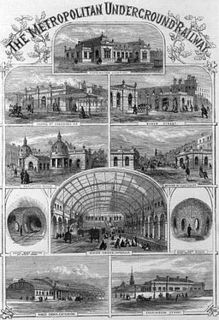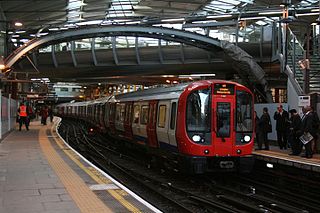
The Metropolitan line, colloquially known as the Met, is a London Underground line that runs between Aldgate in the City of London and Amersham and Chesham in Buckinghamshire, with branches to Watford in Hertfordshire and Uxbridge in the western London Borough of Hillingdon. Coloured magenta on the tube map, the line is 41.4 miles (66.7 km) in length and serves 34 stations. Unlike the deep-tube railways, its tunnels are just below the surface and are of a similar size to those on main lines. Just under 67 million passenger journeys were made on the line in 2011/12.
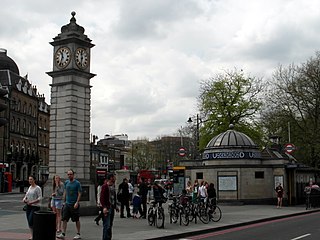
Clapham is a district of south-west London lying mostly within the London Borough of Lambeth, but with some areas extending into the neighbouring London Borough of Wandsworth.

Neasden is an suburban area in northwest London, United Kingdom. It forms part of the London Borough of Brent.

Ruislip is an area in West London, England, which is part of the London Borough of Hillingdon. Ruislip lies 13.8 miles (22.2 km) west-north-west of Charing Cross, London.

Liverpool Street station, also known as London Liverpool Street, is a central London railway terminus and connected London Underground station in the north-eastern corner of the City of London, in the ward of Bishopsgate. It is one of the busiest railway stations in London, serving as the terminus of the West Anglia Main Line to Cambridge, the busier Great Eastern Main Line to Norwich, local and regional commuter trains serving east London and destinations in the East of England, and the Stansted Express service to Stansted Airport.

Middlesex is an ancient county in southeast England. It is now entirely within the wider urbanised area of London. Its area is now also mostly within the ceremonial county of Greater London, with small sections in other neighbouring ceremonial counties. It was established in the Anglo-Saxon system from the territory of the Middle Saxons, and existed as an official unit until 1965. The historic county includes land stretching north of the River Thames from 17 miles (27 km) west to 3 miles (5 km) east of the City of London with the rivers Colne and Lea and a ridge of hills as the other boundaries. The largely low-lying county, dominated by clay in its north and alluvium on gravel in its south, was the second smallest county by area in 1831.
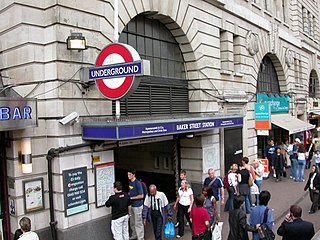
Baker Street is a station on the London Underground at the junction of Baker Street and the Marylebone Road in the City of Westminster. It is one of the original stations of the Metropolitan Railway (MR), the world's first underground railway, opened in 1863.

Watford tube station is the terminus of a Metropolitan line branch line in the north-western part of London Underground in Zone 7. The station opened in 1925.

Wembley Park is a London Underground station in Wembley Park, north west London. The station is served by the Underground's Metropolitan and Jubilee Lines and is in Travelcard Zone 4. It is located on Bridge Road (A4089) and is the nearest Underground station to the Wembley Stadium and Wembley Arena complex. This is where the Jubilee line from Stanmore diverges from the Metropolitan line which was formerly a branch of the Metropolitan Railway and was taken over by the Bakerloo line and today part of the Jubilee line.

Neasden is a London Underground station in Neasden. It is on the Jubilee line, between Wembley Park and Dollis Hill. Metropolitan line trains pass through the station but do not stop, except on rare occasions. The Chiltern Main Line/London to Aylesbury Line runs to the west of the station.
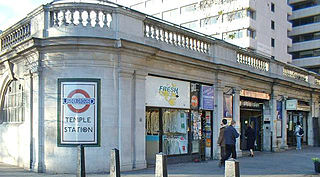
Temple is a London Underground station located at Victoria Embankment in the City of Westminster, close to its boundary with the City of London. It is on the Circle and District lines between Embankment and Blackfriars, and is in fare zone 1.
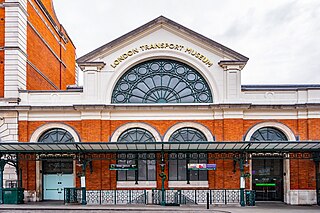
The London Transport Museum, or LT Museum based in Covent Garden, London, seeks to conserve and explain the transport heritage of Britain's capital city. The majority of the museum's exhibits originated in the collection of London Transport, but, since the creation of Transport for London (TfL) in 2000, the remit of the museum has expanded to cover all aspects of transportation in the city.

East London is a popularly and informally defined part of London, capital of the United Kingdom, lying east of the ancient City and north of the River Thames.
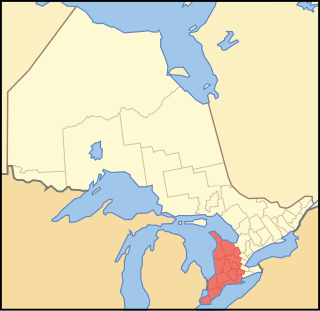
Southwestern Ontario is a secondary region of Southern Ontario in the Canadian province of Ontario. It occupies most of the Ontario Peninsula bounded by Lake Huron, including Georgian Bay, to the north and northwest; the St. Clair River, Lake St. Clair, and Detroit River, to the west; and Lake Erie to the south. To the east, on land, Southwestern Ontario is bounded by Central Ontario and the Golden Horseshoe. The region had a population of 2,583,544 in 2016.

Ruislip Manor is an area of Ruislip in the London Borough of Hillingdon. It is located approximately 13 miles (20.9 km) north west of Charing Cross.

The Tooting Commons consist of two adjacent areas of common land lying between Balham, Streatham and Tooting, in south west London: Tooting Bec Common and Tooting Graveney Common.

Metro-Land is a BBC documentary film written and narrated by the then Poet Laureate of the United Kingdom, Sir John Betjeman. It was directed by Edward Mirzoeff, and first broadcast on 26 February 1973. The film celebrates suburban life in the area to the northwest of London that grew up in the early 20th century around the Metropolitan Railway (MR)—later the Metropolitan line of the London Underground.

Metropolitan Railway electric multiple units were used on London's Metropolitan Railway after the lines were electrified in the early 20th century.

The London Underground opened in 1863 with gas-lit wooden carriages hauled by steam locomotives. The Metropolitan and District railways both used carriages exclusively until they electrified in the early 20th century. The District railway replaced all its carriages for electric multiple units, whereas the Metropolitan still used carriages on the outer suburban routes where an electric locomotive at the Baker Street end was exchanged for a steam locomotive en route.

